African Archery
African Archery – A Continuous Tradition
Researching African archery takes us to the beginning of our species. The oldest archaeological evidence of archery comes to us from the Sibudu Cave, where remains of stone and bone arrowheads have been found, which date to 60,000 to 70,000 years ago. It is interesting, as a researcher of the history of archery, to find archery going so far back. It’s been with us from the beginning, before we could remember, back into our primordial past.
In fact, the practice of archery has been continuous on the African continent throughout all of human history. This article explores African archery, from tribal hunter-gatherers to the African empires at their height.
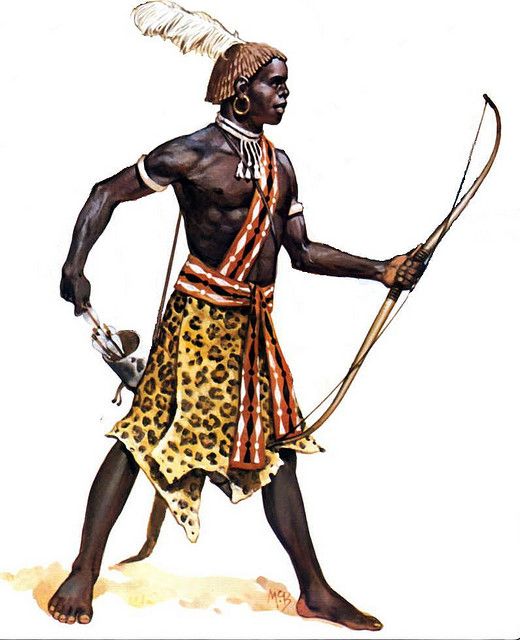
African Archery – Empire Vs Tribal
African archery has been around for as long as recorded history, and likely longer. Despite this, considerably less is known about this continent’s archery traditions as compared to other regions. Studies of African military and weapons systems generally neglect archery, as it is seen primarily as a hunting tool. However, many studies of Africa’s ancient empires and many tribal societies reveal archery as an important tool for military purposes, as well as for hunting.
There is a large number of tribal societies in Africa that practice archery to this day. There also existed a number of notable large and long-lived empires in Africa that were known for their exceptional archers. We will take a brief look at them in the following sections.
Egyptian
The bow and arrow were known and used in Egypt since time immemorial. The angular composite bow was likely introduced to the ancient Egyptians by their rivals to the north, the Hyskos. The ancient Egyptians understood the usefulness of archers in battle. They recruited many archers from the southern lands of Nubia to fight with them as mercenary archers. If you want some more information, read our summary of Egyptian archery here.
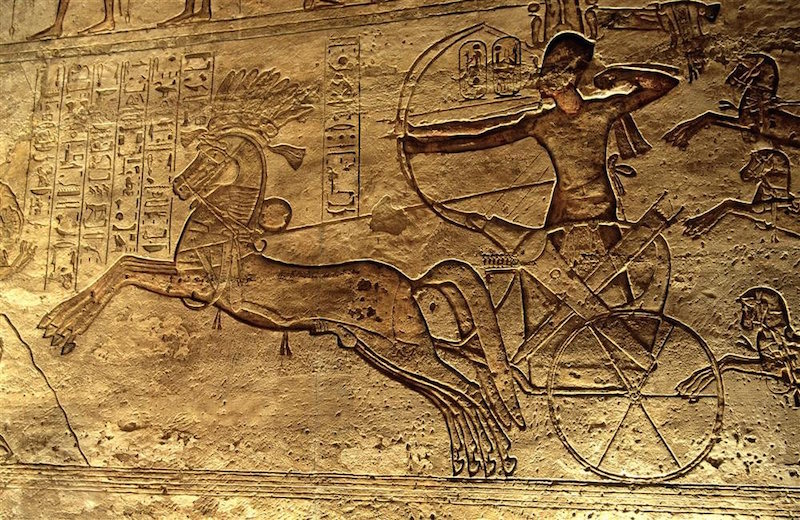
Nubian
The region to the south of the kingdoms of Egypt is known as Nubia. It was home to many empires throughout history, the most prominent of which was called the Kingdom of Kush. The region encompasses modern-day areas of Egypt and Sudan. The ancient Nubians were expert archers, and their neighbors knew it. In fact, the area of Nubia was known as “Ta-Seti,” or “The Land of the Bow,” by their Egyptian neighbors.

The skills of Nubian archers were sought after by Pharaohs for many dynasties. In fact, Egyptian and Nubian culture begins to blur and intertwine in many periods throughout history. There was a time when Egyptian and Nubian elites intermingled and the cultural distinctions between the two areas/empires would dissolve almost entirely. If you look at Nubian statues, sculptures, and artwork you will instantly be reminded of Egyptian artworks. Consider also that Nubian buried their elite in pyramid structures. It is very difficult to determine who truly influenced who, or if perhaps common cultural traits emerged synergistically from both areas simultaneously.
One thing is for certain, the Nubians were truly people of the bow and arrow. Their archery tradition goes back to the beginnings of history. Rock art depicting the use of the bow and arrow in the area of ancient Nubia dates to the neolithic period. Also, throughout Nubia’s history, her people were known as active traders. Many sought after materials were traded with Nubia’s neighbors, especially the Egyptians. Gold, furs, ebony, and ivory were all much sought after commodities. Many of these trade goods, such as furs and ivory, were the result of bowhunting by the Nubians.
Tomb of Mesehti
One of the most intriguing archaeological finds pertaining to African archery is the tomb of Mesehti. He was a provincial governor in ancient Egypt’s 11th dynasty (circa 2000 B.C.) who was buried with many interesting artifacts. The tomb was discovered through illegal excavations in the 19th century A.D. but the majority of the finds were sold to the Cairo Museum. One of the most fascinating finds in the tomb was a set of 40 carved Nubian mercenary archers. They are in marching in stride with their left feet forward, in 4 rows. Carrying bows in one hand, while clutching several arrows in the other, they are naked except for a red cloth kilt. Each was painstakingly carved from wood, and they are all different heights. Also, each warrior has a slightly varied facial expression!
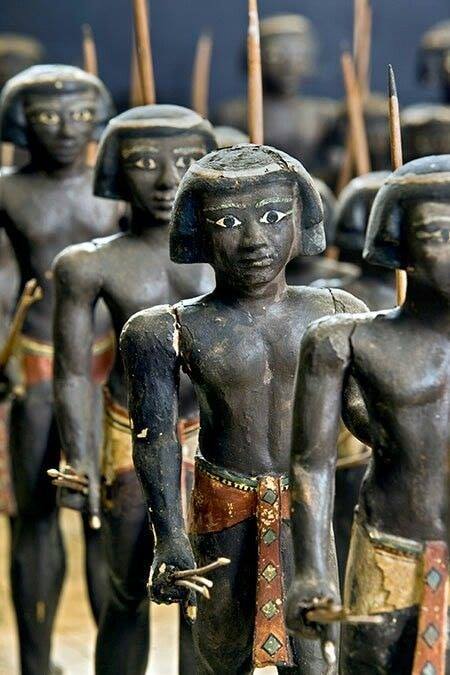
Ethiopian
Hunting and warfare were conducted with the bow and arrow in Ethiopia for millennia. The ethnic group known as the Maya (not to be confused with the Central American natives) were renowned for their exceptional archery skills. Very much like the Nubians of old, they were sought after as mercenaries.
The African Bow
The most common form of traditional African bow, from archaeology and modern users, has the following characteristics:
- Simple wood stave, variation in the type of wood
- Round cross-section
- Gradual tapering at the tips
- Flattened or grooved staves occur, but less frequently
- Moderate lengths (typically ranging from 100 to 170
centimeters) - Various string attachment techniques (including eyeleted, knotted, etc.)
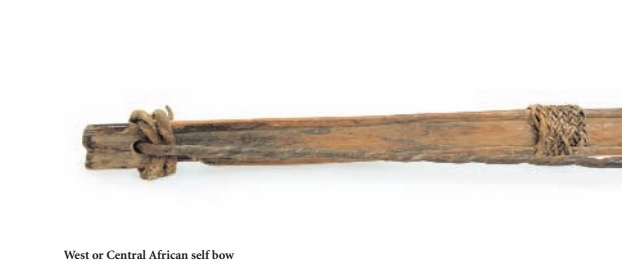
Tribal
Several tribes and tribal confederations have inhabited Africa since the beginning of history and still do to this day. All of them have practiced archery in one form or another as a means of survival. These are but a few of the many unique tribes and people that practice archery in Africa.
Ju/’hoansi
The Ju/’hoansi (!Kung, Ju/Wasi) Bushmen are a population of Khoisan-speaking former hunter-gathers residing in northeastern Namibia and the northwestern Kalahari Desert region of Botswana.
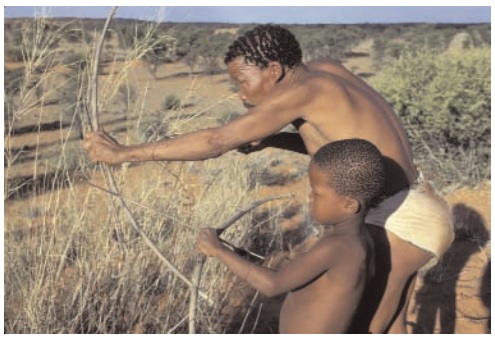
Maasai
The Massai are an ethnic group inhabiting northern, central, and southern Kenya and northern Tanzania. They are exceptional marksman with the bow and the spear. Their warriors are recognizable by their bright red clothing.
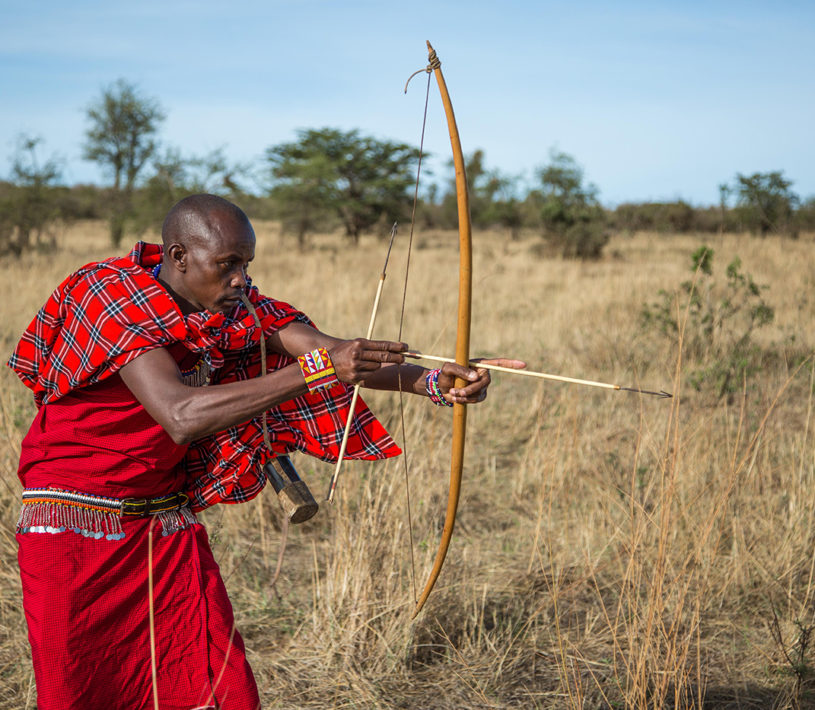
Hadza, or Hadzabe
The Hadzabe people are a group inhabiting north-central Tanzania. Only a few hundred remain as traditional hunter-gatherers. They craft some of the larger bows of the African tribes and know how to use them as well.
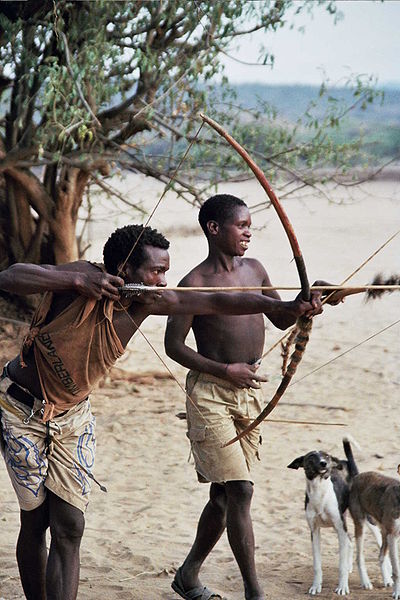
Modern African Archery
Drawing on Africa’s long tradition of archery, the continent and it’s people participate in compound and recurve archery as well. Check out The Federation of African Archery’s (FAA) website here: http://www.africanarchery.org/
Many nations in Africa are now participating members of the FAA:
- MRI Mauritius
- MAR Morocco
- NAM Namibia
- NIG Niger
- NGR Nigeria
- SEN Senegal
- SOM Somalia
- SUD Sudan
- RSA South Africa
- RWA Rwanda
- TUN Tunisia
- UGA Uganda
- ZIM Zimbabwe